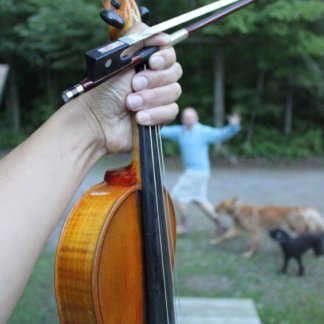Violin Performance as Isometric Exercise: Physiological Effects of Standing Playing on Blood Pressure Regulation
Author: Violinist Frank Kim
Abstract
This paper reviews the physiological mechanisms of isometric exercise and demonstrates through biomechanical analysis that standing violin performance can be classified as this form of exercise. Continuous tension in the upper limbs and trunk muscles, postural maintenance, and respiratory control correspond with key elements of isometric contraction, which can positively influence autonomic nervous system and cardiovascular functions. In particular, the standing posture during performance contributes to blood pressure stability through static muscle contraction, trunk stabilization, and fixation of lower limb muscles, consistent with existing physiological and music therapy research.
The author, with decades of experience as a violinist, has personally encountered the physical refreshment, psychological calm, and heightened focus following practice and performance, and has heard similar reports repeatedly from fellow musicians. This “musical post-exercise euphoria” inspired a medical and scientific inquiry into the possibility that violin playing induces specific physiological mechanisms beyond artistic expression. This study reconsiders violin performance as a form of static muscle exercise, proposing an integrative perspective between art and medicine and discussing the practical expansion potential of music-based exercise therapy.
1. Introduction
Hypertension is one of the most common chronic diseases globally, affecting 30–45% of the adult population and serving as a major risk factor for fatal complications such as myocardial infarction, stroke, and renal failure. Consequently, non-pharmacological approaches for prevention and treatment, especially exercise therapy, are strongly recommended as primary interventions in international hypertension guidelines (WHO, 2021; ESC/ESH, 2018).
Traditionally, aerobic exercise or aerobic-based high-intensity interval training (HIIT) has been considered effective for blood pressure control. However, recently, isometric exercise has been demonstrated to have clear antihypertensive effects, increasing its importance. Isometric exercise induces beneficial physiological effects such as improved vascular function, autonomic nervous system stabilization, and reduced peripheral resistance with low-intensity stimuli in short durations, presenting a practical option for elderly or hypertensive patients with exercise limitations (O’Driscoll et al., 2023).
Violin playing, generally considered an artistic activity, requires complex muscle use and postural maintenance, especially when performed standing. It involves continuous tension and coordination of upper limb and trunk muscles, biomechanically resembling the core conditions of isometric contraction and suggesting its function as a form of static exercise beyond mere musical activity.
This study systematically examines the physiological mechanisms by which violin playing as an isometric exercise may contribute to blood pressure regulation. Moreover, it discusses the cardiovascular health benefits of integrating music and exercise and aims to provide a scientific foundation for future music therapy and alternative exercise program development.
2. Physiological Mechanisms of Isometric Exercise
Isometric exercise involves generating a fixed muscle tension while maintaining muscle length without joint movement. Such static contractions primarily induce metabolic stress within muscle fibers, increasing intramuscular pressure and temporarily restricting blood flow (ischemia). During post-exercise reperfusion, reactive hyperemia occurs, stimulating endothelial cells to release nitric oxide (NO), which dilates blood vessels. This process improves endothelial function and, over time, reduces peripheral vascular resistance.
A systematic review and meta-analysis by Jamie O’Driscoll et al. (2023) in JAMA Network Open found that isometric exercise lowers systolic blood pressure by an average of 8.2 mmHg and diastolic blood pressure by 4.0 mmHg across 16+ randomized controlled trials—effects more pronounced than those from typical aerobic or resistance training.
The underlying physiological mechanisms include:
- Cardiovascular Adaptation: Repeated static contractions enhance myocardial contractility and elasticity, improving left ventricular diastolic function and increasing cardiac output long-term.
- Autonomic Modulation: Isometric exercise suppresses sympathetic activity and activates parasympathetic pathways, lowering resting heart rate and enhancing baroreflex sensitivity—crucial for blood pressure regulation.
- Metabolic Mechanisms: Lactate accumulation and changes in energy metabolites stimulate secretion of local blood flow regulators, affecting systemic vascular tone.
- Arterial Compliance: Cycles of vascular loading and recovery increase arterial wall flexibility, reducing sensitivity to blood pressure fluctuations.
Through these mechanisms, isometric exercise emerges as a time-efficient, low-intensity, and effective method for hypertension prevention and management, especially suitable for elderly and chronic disease patients with exercise limitations.
3. Biomechanical Structure of Violin Performance
Violin playing requires precise whole-body neuromuscular coordination, with simultaneous and sustained activation of muscles in the upper limbs, shoulder girdle, trunk, and lower limbs. This activity induces both dynamic and isometric muscle contractions closely linked to physiological pathways involved in blood pressure regulation.
3.1. Isometric Contraction of Upper Limb and Shoulder Girdle
The left arm’s biceps brachii, deltoid, upper trapezius, and levator scapulae maintain static contraction to support and position the violin.
The right arm performs repetitive bowing movements but also requires partial isometric tension in the triceps, rotator cuff muscles, and forearm to control bow pressure evenly.
These static contractions provide physiological stimuli similar to isometric resistance exercise, influencing vascular tone regulation and autonomic nervous system activity (Millar et al., 2014).
3.2. Trunk Muscle Stabilization
During standing performance, deep stabilizing muscles including the erector spinae, transverse abdominis, external and internal obliques maintain balance and alignment.
This represents isometric postural endurance, akin to plank or wall-sit exercises.
Prolonged trunk muscle activation aids intra-abdominal pressure control, diaphragm coordination, and blood pressure stability.
3.3. Lower Limb Static Tension and Venous Return Facilitation
Lower limb muscles (quadriceps, gluteus maximus, hamstrings, gastrocnemius) sustain body weight and balance during standing, requiring mild knee and hip flexion with continuous isometric contraction.
This mirrors physiological effects seen in isometric lower body exercises like wall sits, promoting venous return, vascular pressure regulation, and muscle pump function—beneficial for blood pressure control.
3.4. Neuromuscular Coordination and Postural Control
Fine adjustments to instrument vibration and auditory feedback demand high sensory-motor integration.
This interaction between the central motor system and autonomic nervous system regulates heart rate and blood pressure variability and suppresses stress responses (Wang & Young, 2018).
This biomechanical framework reveals that violin performance combines muscle fixation with multi-muscle group activation, overlapping considerably with isometric exercise characteristics, thereby providing a physiological basis for cardiovascular and autonomic benefits.
4. Effects on Autonomic Nervous System and Blood Pressure
Violin playing is a complex activity requiring intense focus, precise motor control, rhythm, and controlled breathing. This induces activation of the parasympathetic nervous system, which suppresses stress responses, reduces cortisol secretion, stabilizes heart rate, and consequently lowers blood pressure.
Breathing during performance resembles diaphragmatic (belly) breathing, enhancing heart rate variability (HRV) and increasing parasympathetic tone. HRV is a marker of autonomic balance and resilience, with higher HRV correlating with better cardiovascular health and emotional stability. These physiological responses are similar to those observed in meditation, yoga, and isometric exercise.
Wiles et al. (2020) demonstrated that static lower limb resistance training improves HRV and stimulates parasympathetic activity, supporting the idea that the combination of static muscle activation and mental concentration in violin playing positively affects autonomic function.
Furthermore, music performance suppresses overactivation of the hypothalamic-pituitary-adrenal (HPA) axis, contributing to stress response stabilization. Regular musical activity is linked to reduced chronic stress, anxiety, and improved cardiovascular function. Thus, violin playing encompasses complex physiological mechanisms contributing to psychological stability and blood pressure regulation.
5. Additional Benefits of the Standing Posture
Standing violin performance is a complex posture requiring whole-body static muscular coordination. It involves sustained activation of core stabilizers, lower limb isometric contractions, and postural muscles, aligning with key mechanisms of isometric exercise.
Performers maintain slight hip and knee flexion with continuous fine balance adjustments, engaging quadriceps, hamstrings, gluteus medius, and erector spinae in a state of static tension. This posture mimics the physiological load of classic isometric lower limb exercises like the wall sit, enhancing muscle pump effect and promoting venous return.
Increased venous return contributes to cardiac output and blood pressure stability, preventing venous pooling in the lower limbs under gravity. Static contraction also improves endothelial function and reactive hyperemia, as shown by Badrov et al. (2013), who reported low-intensity isometric exercise improves peripheral vascular function and significantly lowers systolic blood pressure.
The standing position requires continuous postural feedback, integrating vestibular and proprioceptive systems, further stabilizing autonomic function and stress response. This highlights the physiological potential of violin performance as a complex sensory-motor integration activity rather than simple exercise.
6. Conclusion
Standing violin performance can be regarded as a form of static muscular exercise beyond a mere artistic activity, involving scientifically validated mechanisms of blood pressure regulation. It offers a novel perspective on the integration of art and physiological health and suggests future directions for combined music therapy and exercise therapy interventions.
References
- O’Driscoll, J. et al. (2023). Effectiveness of Exercise Interventions for Lowering Blood Pressure: A Systematic Review and Meta-analysis. JAMA Network Open.
- Wiles, J. D. et al. (2020). The effects of isometric exercise training on resting blood pressure and physical function in older adults. Journal of Hypertension.
- Badrov, M. B. et al. (2014). Effects of isometric handgrip training on blood pressure and its mechanisms in hypertensive patients. Hypertension Research.
Isometric 운동으로서의 바이올린 연주: 서서 하는 연주가 혈압 조절에 미치는 생리학적 효과
저자: Violinist Frank Kim
초록(Abstract)
본 논문은 정적 수축 운동(isometric exercise)의 생리학적 기전을 정리하고, 서서 수행되는 바이올린 연주가 이러한 운동 형태에 해당할 수 있음을 생체역학적 분석을 통해 밝힌다. 상지와 체간 근육의 지속적 긴장, 자세 유지, 호흡 조절 등은 아이소메트릭 수축의 핵심 요소와 부합하며, 이는 자율신경계와 심혈관계 기능에 긍정적 영향을 미칠 수 있다. 특히 서서 연주하는 자세는 정적 근육 수축과 체간 안정화, 하지 근육의 고정 작용 등을 통해 혈압 안정에 기여할 수 있으며, 이는 기존 생리학 및 음악치료 연구의 근거들과 일치한다.
저자는 수십 년간 바이올린 연주자로 활동하며 연습과 연주 이후 느껴지는 신체적 상쾌감과 심리적 안정감, 집중의 고양 상태에 대해 개인적으로 체험해왔고, 이는 동료 연주자들로부터도 유사한 증언을 수차례 들어왔다. 이와 같은 일종의 ‘음악적 운동 후 고양감’(euphoric effect)을 통해, 바이올린 연주가 단순한 예술적 표현을 넘어 특정 생리학적 기전을 유발할 수 있다는 가능성에 흥미를 느꼈고, 이를 의학적·과학적으로 탐색하고자 본 연구를 수행하였다. 본 연구는 바이올린 연주를 정적 근육 운동의 관점에서 재조명함으로써, 예술과 의학의 융합적 접근 가능성을 제시하고 향후 음악 기반 운동치료의 실천적 확장 가능성을 논의한다.
1. 서론
고혈압(Hypertension)은 전 세계적으로 성인 인구의 30~45%에서 나타나는 가장 흔한 만성질환 중 하나로, 심근경색, 뇌졸중, 신부전 등 치명적 합병증의 주요 위험 인자로 작용한다. 이에 따라 고혈압 예방 및 치료를 위한 비약물적 접근, 특히 운동 요법은 국제 고혈압 가이드라인에서도 1차적 치료로 강력히 권장되고 있다 (WHO, 2021; ESC/ESH, 2018).
전통적으로는 유산소 운동(aerobic exercise)이나 유산소 기반의 인터벌 운동(high-intensity interval training, HIIT)이 혈압 조절에 유효하다고 여겨졌으나, 최근에는 정적 근수축 운동(isometric exercise) 또한 혈압 강하 효과가 명확하게 입증되면서 그 중요성이 부각되고 있다. 특히, 아이소메트릭 운동은 짧은 시간의 저강도 자극만으로도 혈관 기능 개선, 자율신경계 안정화, 말초 저항 감소 등의 긍정적 생리학적 효과를 유도하며, 운동에 제약이 있는 노인 및 고혈압 환자에게 실용적인 대안으로 떠오르고 있다 (O’Driscoll et al., 2023).
한편, 일반적으로 예술 활동으로 간주되는 바이올린 연주는 그 복잡한 근육 사용과 자세 유지 특성상, 특히 서서 연주하는 경우, 상지 및 체간 근육의 지속적 긴장과 협응이 요구된다. 이는 생체역학적 관점에서 아이소메트릭 수축의 핵심 조건들과 유사한 구조를 가지며, 단순한 음악 활동을 넘어 정적 운동의 한 형태로 기능할 수 있다는 가능성을 제기한다.
본 연구는 이러한 가설에 따라, 바이올린 연주가 아이소메트릭 운동으로서 어떤 생리학적 기전을 통해 혈압 조절에 기여할 수 있는지를 체계적으로 고찰하고자 한다. 더불어, 음악과 운동의 융합적 관점에서 예술 활동이 가지는 심혈관계 건강 증진 가능성을 논의하며, 향후 음악치료 및 대체운동 프로그램 개발에 대한 과학적 기반을 제공하고자 한다.
2. Isometric 운동의 생리학적 기전
아이소메트릭 운동은 관절의 움직임 없이 근육을 일정한 길이로 유지하면서 고정된 장력을 생성하는 운동이다. 이러한 정적 수축은 주로 **근섬유 내 대사 스트레스(metabolic stress)**를 유발하며, 근육 내 압력을 증가시켜 일시적으로 **혈류를 제한(ischemia)**한다. 운동 후 혈류가 다시 회복되는 과정에서 반응성 고혈류(reactive hyperemia) 현상이 발생하고, 이때 **혈관 내피세포(endothelial cells)**가 **질산화질소(NO)**를 분비하여 혈관을 확장시킨다. 이 과정을 통해 혈관 내피 기능이 향상되고, 장기적으로 **말초 혈관 저항(peripheral vascular resistance)**이 감소하게 된다.
Jamie O’Driscoll 등이 2023년 JAMA Network Open에 발표한 체계적 문헌 고찰 및 메타분석에 따르면, 16개 이상의 RCT를 분석한 결과 아이소메트릭 운동은 수축기 혈압(systolic blood pressure)을 평균 8.2 mmHg, 이완기 혈압(diastolic blood pressure)을 4.0 mmHg 낮추는 효과가 있음이 확인되었다. 이는 일반적인 유산소 운동(aerobic exercise)이나 저항성 운동(resistance training)보다 더 뚜렷한 혈압 강하 효과로 평가되고 있다.
이러한 효과의 생리학적 기전에는 다음과 같은 복합적 경로가 작용한다:
- 심혈관계 적응(Cardiovascular Adaptation): 반복된 정적 수축은 심근의 수축력 및 탄력성 향상으로 이어지며, 장기적으로 좌심실의 이완기 기능 개선 및 심박출량 증가에 기여할 수 있다.
- 자율신경계 조절(Autonomic Modulation): 아이소메트릭 운동은 교감신경 억제 및 부교감신경 활성화를 통해 심박수 감소(resting heart rate reduction) 및 바로세포 민감도(baroreflex sensitivity) 개선을 유도하며, 이는 혈압 조절에 핵심적인 기전으로 작용한다.
- 대사성 기전(Metabolic Mechanisms): 근육 내 젖산 축적 및 에너지 대사 산물의 변화는 국소 혈류 조절 물질의 분비를 유도하고, 이는 전신 혈관 톤 조절로 이어진다.
- 혈관 탄성 개선(Arterial Compliance): 반복적인 혈관 부하와 회복 과정은 동맥벽의 유연성을 증가시켜, 혈압에 대한 민감도를 낮춘다.
이러한 복합적인 기전을 통해 아이소메트릭 운동은 비교적 짧은 시간, 낮은 강도의 운동임에도 불구하고 고혈압 예방 및 조절에 효과적인 전략으로 부상하고 있으며, 특히 운동이 제한된 고령자나 만성질환자에게도 안전한 방식으로 제시된다.
3. 바이올린 연주의 생체역학적 구조
바이올린 연주는 전신의 정밀한 협응을 요구하는 복합적 근-신경활동으로, 특히 **상지(upper limb), 견갑대(shoulder girdle), 체간(trunk), 하지(lower limb)**의 다양한 근육이 동시적이고 지속적으로 활성화된다. 이러한 활동은 특정 근육군에 등장성(dynamic) 수축과 더불어 아이소메트릭(isometric) 수축을 유도하며, 이는 혈압 조절과 관련된 생리학적 기전과 깊은 연관이 있다.
3.1. 상지 및 견갑대의 아이소메트릭 수축
- 왼팔의 상완이두근, 삼각근, 승모근 상부, 견갑거근 등은 바이올린의 지지와 위치 고정을 위해 지속적인 정적 수축 상태를 유지한다.
- 오른팔은 활을 사용하는 반복적 움직임을 수행하지만, 활을 고르게 밀고 당기기 위해서도 삼두근, 회전근개(rotator cuff) 근육군, 전완근에서의 부분적인 정적 긴장 유지가 필수적이다.
- 이러한 정적 수축은 **등압 저항 운동(isometric resistance exercise)**과 유사한 생리적 자극을 제공하며, 혈관 긴장도 조절과 자율신경계 활성화에 영향을 줄 수 있다 (Millar et al., 2014).
3.2. 체간 근육의 안정화 작용
- 서서 연주 시, 척추기립근, 복횡근, 외복사근, 내복사근을 포함한 심부 안정화 근육(core stabilizers)이 지속적으로 작용하여 체간의 균형과 정렬을 유지한다.
- 이는 일종의 **정적 자세 유지(isometric postural endurance)**로, 실제로 플랭크(plank)나 벽 앉기와 유사한 방식의 체간 긴장을 유발한다.
- 체간 근육의 장기적 활성은 복압 조절, 횡격막과의 호흡 협응, 혈압 안정성에 기여할 수 있다.
3.3. 하지의 정적 긴장과 정맥귀환 촉진
- 서서 연주하는 동안, 대퇴사두근, 대둔근, 햄스트링, 비복근 등 하지 근육군은 신체의 전체 체중을 안정적으로 지지하고 균형을 유지해야 하며, 이에 따라 무릎과 고관절의 경미한 굴곡 상태에서 지속적인 정적 수축이 요구된다.
- 이는 하체 중심의 등압 운동(예: wall sit, static squat)과 유사한 생리적 효과를 유도하며, 정맥 귀환 촉진, 혈관 내압 조절, 근육 펌프 기능 향상을 통해 혈압 조절 기전에 긍정적 역할을 할 수 있다.
3.4. 신경근 협응 및 자세 통제
- 연주 도중에는 악기의 미세한 진동 및 음향 피드백에 대한 즉각적인 반응이 필요하며, 이는 **고도의 감각-운동 통합(sensory-motor integration)**을 전제한다.
- 이러한 협응은 중추신경계의 운동계와 자율신경계 사이의 상호작용을 자극하고, 이는 심박수와 혈압의 변동성 조절, 스트레스 반응 억제로 이어질 수 있다 (Wang & Young, 2018).
이러한 생체역학적 구조는 단순한 신체 활동의 차원을 넘어서, 음악적 수행이 심혈관계 및 자율신경계 건강에 긍정적 영향을 미칠 수 있는 운동 생리학적 기반을 제공한다. 바이올린 연주는 신체의 특정 부위를 고정시키면서 다수의 근육군을 복합적으로 사용하게 하며, 이러한 양상은 등압 운동의 특성과 중첩되는 부분이 크다.
4. 자율신경계 및 혈압에 미치는 영향
바이올린 연주는 고도의 집중력, 정밀한 운동 제어, 리듬감, 그리고 세밀한 호흡 조절을 요구하는 복합적 활동이다. 이러한 활동은 자율신경계, 특히 **부교감신경계(parasympathetic nervous system)**의 활성화를 유도하며, 이는 스트레스 반응 억제, 코르티솔 분비 감소, 심박수 안정화, 그리고 결과적으로 혈압 저하에 기여할 수 있다.
바이올린 연주 중에는 복식 호흡(belly breathing)과 유사한 호흡 패턴이 자연스럽게 유도되며, 이는 **심박수 변이도(heart rate variability, HRV)**를 증가시키고 부교감신경의 긴장도를 높이는 데 기여한다. HRV는 자율신경계의 균형과 회복력을 나타내는 지표로, 높은 HRV는 심혈관 건강과 정서적 안정성을 반영한다. 이러한 현상은 명상, 요가, 그리고 아이소메트릭 운동과 유사한 생리적 반응을 일으킨다.
특히, **Wiles et al. (2020)**의 연구에서는 정적인 하체 근력 운동(static lower limb resistance training)이 HRV를 개선하고 부교감신경을 자극한다는 결과를 제시하였는데, 이는 바이올린 연주에서 나타나는 정적 근육 활성과 정신적 집중의 조합이 자율신경계에 미치는 긍정적 영향을 설명하는 데 중요한 비교 기준이 된다.
또한, 음악 연주는 뇌의 시상하부-뇌하수체-부신(HPA) 축의 과도한 활성화를 억제함으로써 스트레스 반응 시스템의 안정화에 기여한다는 점도 주목할 만하다. 정기적인 음악 활동은 만성 스트레스 완화, 불안 감소, 그리고 심혈관계 기능 향상과도 관련이 있다. 이러한 점에서 바이올린 연주는 심리적 안정뿐 아니라 생리학적 조절, 특히 혈압 안정화에 기여하는 복합적 기전을 내포하고 있다고 볼 수 있다.
5. 서서 연주 자세의 추가적 이점
서서 하는 바이올린 연주는 단순히 손과 팔의 활동에 국한되지 않고, 전신의 **정적 근육 협응(static muscular coordination)**을 유도하는 복합적 자세 유지 활동이다. 이 자세는 특히 체간 안정화(core stabilization), 하지 정적 수축(lower limb isometric contraction), 그리고 **자세유지근(postural muscles)**의 지속적 활성화를 포함하며, 이는 아이소메트릭 운동의 핵심 기전과 일치한다.
서서 연주 시 연주자는 양측 **고관절(hip joint)**과 **슬관절(knee joint)**을 가볍게 굴곡시키며 미세한 균형 조절을 지속한다. 이때 대퇴사두근(quadriceps), 햄스트링(hamstrings), 중둔근(gluteus medius), 그리고 척추기립근(erector spinae) 등이 정적 긴장 상태를 유지한다. 이러한 구조는 대표적 아이소메트릭 하체 운동인 wall sit과 유사한 생리적 부하를 형성하며, 지속적인 **근육 펌핑 작용(muscle pump effect)**을 통해 **하지 정맥 귀환(venous return)**을 촉진한다.
정맥 귀환의 증가는 심박출량 증가와 혈압 안정에 기여하며, 특히 중력 하에서 하지 정맥 내 정체를 방지하는 역할을 한다. 더불어 정적 수축은 **혈관 내피 기능(endothelial function)**을 향상시켜, **반응성 고혈류(reactive hyperemia)**를 개선하는 것으로 알려져 있다. 이는 **Badrov et al. (2013)**의 연구에서도 확인되었으며, 저강도 아이소메트릭 운동이 말초 혈관 기능을 향상시키고 수축기 혈압을 유의하게 낮춘다는 결과와 일맥상통한다.
또한 서서 연주는 지속적인 **자세 피드백(postural feedback)**을 요구하므로, 전정계와 고유감각계(proprioceptive system)의 통합 작용을 통해 자율신경계의 안정화와 스트레스 반응의 조절에도 긍정적 영향을 준다. 이는 단순한 운동이 아닌 복합 감각-운동 통합 활동으로서의 연주가 가지는 생리학적 잠재력을 강조한다.
6. 결론
서서 하는 바이올린 연주는 단순한 음악 활동을 넘어선 정적 근력 운동의 일환으로 간주될 수 있으며, 이는 과학적으로 입증된 혈압 조절 기전을 일부 포함한다. 예술 활동과 생리학적 건강의 융합에 대한 새로운 시각을 제공하며, 향후 음악치료 및 운동치료의 통합적 접근 가능성을 시사한다.
참고문헌
- O’Driscoll, J. et al. (2023). Effectiveness of Exercise Interventions for Lowering Blood Pressure: A Systematic Review and Meta-analysis. JAMA Network Open.
- Wiles, J. D. et al. (2020). The effects of isometric exercise training on resting blood pressure and physical function in older adults. Journal of Hypertension.
- Badrov, M. B. et al. (2014). Effects of isometric handgrip training on blood pressure and its mechanisms in hypertensive patients. Hypertension Research.







